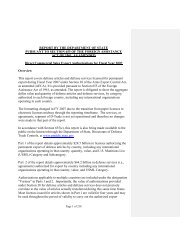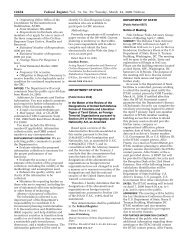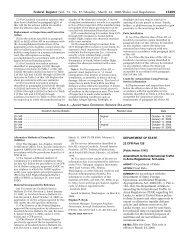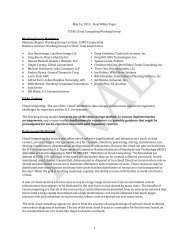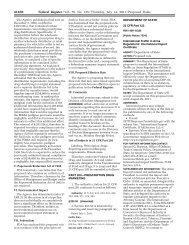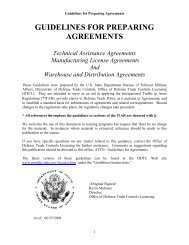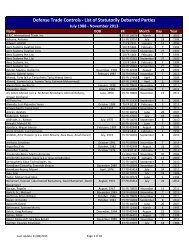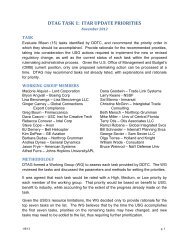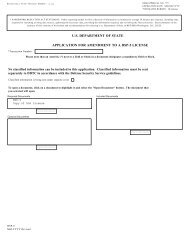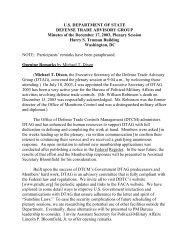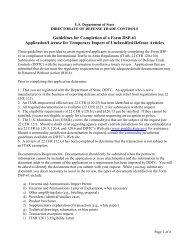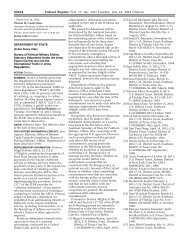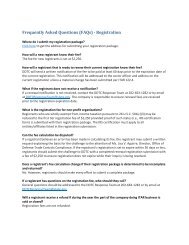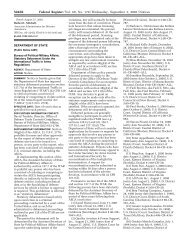Cloud Computing - Directorate of Defense Trade Controls
Cloud Computing - Directorate of Defense Trade Controls
Cloud Computing - Directorate of Defense Trade Controls
You also want an ePaper? Increase the reach of your titles
YUMPU automatically turns print PDFs into web optimized ePapers that Google loves.
The use <strong>of</strong> the term “cloud computing” and thus the “cloud symbol” began to be used to denote the portion <strong>of</strong><br />
an information system for which the provider was responsible vs. the portion <strong>of</strong> an information system for<br />
which the users were responsible. The boundary between a user and the cloud depends on the circumstance.<br />
For example, the boundary <strong>of</strong> the cloud can start at the wireless interface to a cellular network <strong>of</strong> a handheld<br />
device or start at an enterprise network interface to the world-wide-web.<br />
DTAG Assignment<br />
<strong>Cloud</strong> <strong>Computing</strong>: The use <strong>of</strong> the “cloud” method for storage <strong>of</strong> technical data creates some significant<br />
regulatory challenges for those who use the cloud to create, collect, process, store, maintain, use, share,<br />
transmit, disseminate, or dispose <strong>of</strong> "technical data". Consequently, such use <strong>of</strong> a cloud also creates some<br />
significant regulatory issues for the U.S. Government. While the focus <strong>of</strong> the DTAG Working Group primarily<br />
has been on the use <strong>of</strong> a cloud for storage, the Working Group has also considered the legal and regulatory<br />
implications <strong>of</strong> the movement (e.g., transmission) <strong>of</strong> technical data to, within and from a cloud. The DTAG<br />
Working Group did not include the issues related to outsourcing <strong>of</strong> enterprise information systems in its<br />
scope but noted that many <strong>of</strong> the issues raised by cloud computing are implicated in the use <strong>of</strong> outsourced IT<br />
services.<br />
1) Review on use <strong>of</strong> <strong>Cloud</strong> as storage method<br />
a. DTAG concluded that the risks to national security and foreign policy <strong>of</strong> unauthorized export <strong>of</strong><br />
technical data have increased in near lock step with the exponential technical advances in<br />
computational speed, data storage capacity and communication speed that have been achieved in the<br />
past fifty years. These risks are manifested in the use <strong>of</strong> cloud computing for data storage (as well as<br />
for other uses). The DTAG is mindful that data storage includes not only storage <strong>of</strong> information in<br />
databases but also the storage <strong>of</strong> data in devices attached to or making up the cloud. The location <strong>of</strong><br />
cloud infrastructure in several different countries raises numerous legal questions relating to<br />
whether the storage <strong>of</strong> data in that infrastructure or the movement <strong>of</strong> data to, from or between<br />
devices attached to the infrastructure could involve unauthorized exports <strong>of</strong> technical data. Finally,<br />
the DTAG considered the benefits to industry and to Government <strong>of</strong> the use <strong>of</strong> cloud computing in<br />
terms <strong>of</strong> both cost and efficiency.<br />
b. The DTAG reviewed several scenarios including the following:<br />
Company XYZ (located in the U.S.) engages with <strong>Cloud</strong> <strong>Computing</strong> Service Provider ABC<br />
(who may or may not have a presence in the U.S.) for its data storage needs (which<br />
include “technical data”);<br />
Company ABC has cloud infrastructure located in the United States, Canada, United<br />
Kingdom, India and Brazil and communication links between the devices constituting<br />
infrastructure;<br />
The following questions arise from the scenario above:<br />
• What are the regulatory risks that XYZ will face in utilizing ABC for storage (and<br />
other uses) <strong>of</strong> technical data?<br />
• How can XYZ ensure its data is secure?<br />
• How can XYZ adapt to changing computing and storage needs?<br />
• What is the responsibility <strong>of</strong> ABC for protecting ITAR controlled technical data<br />
that is stored in the cloud?<br />
2) Review the various cloud implementation arrangements<br />
a. The DTAG reviewed the implementation arrangements and found that <strong>Cloud</strong> computing services<br />
are <strong>of</strong>fered in multiple environments:<br />
i. Public cloud – cloud infrastructure that is open to use by the public pursuant to standard<br />
terms and conditions that are applicable to all users. Public clouds also arise in two,<br />
more restrictive, forms.<br />
1. Hybrid <strong>Cloud</strong> – This cloud is a combination <strong>of</strong> two or more cloud infrastructures<br />
that retain their own properties but enable data and applications to move<br />
across the multiple types <strong>of</strong> clouds.<br />
2



